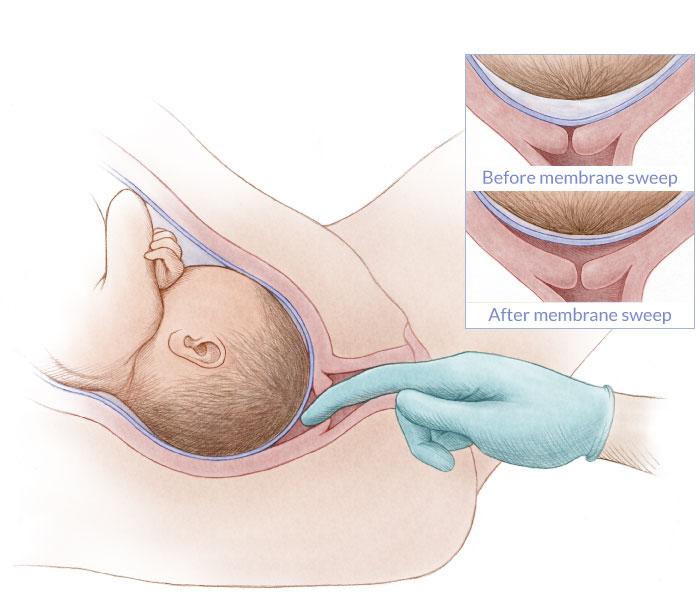Membrane sweeping, sometimes called “stripping the membranes” or “stretch and sweep of the cervical membranes”, is a technique used to stimulate labor. It is a technique most often performed by obstetricians or midwives to help a woman go into labor without having an induction with oxytocin because it stimulates prostaglandins in the cervix, causing contractions and further cervical dilatation. But how effective is the technique? Is it safe? Read on to find out.
What Is the Membrane Sweep Success Rate?
The success rate is about 24% in 48 hours; if labor is not induced succesfully, more measures will be taken after 36 hours.
According to statistics, about 24 percent of people who get a membrane sweep will go into labor within 48 hours after having the procedure. Almost all women will have their baby within a week of having a membrane sweep performed. With the membrane sweep success rate being 24%, doctors may repeat the procedure in 36 hours if the woman hasn't gone into labor after the first time having the procedure done.
Some midwives and obstetricians will do a membrane sweep at every prenatal visit beginning at 38 weeks gestation; however, it can be a risky procedure and is not a medically necessary thing to do. If the procedure is done and a woman does not go into labor, the doctor or midwife may perform an artificial rupture of membranes and begin the patient on a Pitocin IV infusion.
When Is a Membrane Sweep Necessary?
A membrane sweep is usually required once you officially become overdue, which is about 41 weeks' gestation. There are other reasons you may need to have a membrane sweep, including the following:
- You are suffering from a pregnancy-related medical condition, including pre-eclampsia, gestational diabetes, obstetric cholestasis or dysfunction of the pubic symphysis.
- If the fetal growth is not as good as the doctors are expecting and it would be better to have the baby out.
- If you are having twins and a vaginal delivery is anticipated. Once you get past 37 weeks, you often get tired out and would do well to have the babies. The membrane sweep success rate is usually pretty good after 37 weeks with twins.
A membrane sweep will not be performed if there is any indication of an ongoing vaginal infection or if you have already ruptured your membranes. In such cases, a formal induction with Pitocin will be carried out instead.
How Is It Done?
Before the Procedure
Prior to doing the procedure, the obstetrician or midwife will tell you about what they are about to do and ask for your consent. You need to be completely aware of the risks and benefits of having a membrane sweep before going through with it. This is also a good time to ask about the membrane sweep success rate.
You should empty your bladder before the procedure to make it more comfortable. The healthcare provider will perform an abdominal exam to make sure the head is down and will hear the fetus' heart rate. If anything is abnormal on the examination, the membrane sweep will not be performed.
During the Procedure
 The doctor or midwife will insert two fingers into the vagina and place their index finger through the partially opened cervix. They will assess whether or not the cervix is favorable for labor and is soft, thinning out and beginning to become dilated. If the cervix is closed and difficult to reach, the membrane sweep success rate will be very low and the procedure will be uncomfortable to do if it can be done at all.
The doctor or midwife will insert two fingers into the vagina and place their index finger through the partially opened cervix. They will assess whether or not the cervix is favorable for labor and is soft, thinning out and beginning to become dilated. If the cervix is closed and difficult to reach, the membrane sweep success rate will be very low and the procedure will be uncomfortable to do if it can be done at all.
Then the doctor or midwife will touch the amniotic sac or "membranes" and will stretch out the cervix so that it is open enough to get the finger to sweep around it. When the finger is swept around the cervix, the membranes are separated from the cervical tissue and prostaglandins that help start labor will be released.
If the cervix is closed and a membrane sweep is not possible, the doctor or midwife will massage the cervix in order to release as much prostaglandins as possible. If the cervix is open, the provider will try to move their index finger in a circular fashion a full 360 degrees around the cervix. They need to do this without rupturing the membranes in the process. If the membranes are already bulging, they may break spontaneously during the procedure.
Possible Risks Associated with It
This is considered to be a very safe procedure in general and it is effective in increasing the contractions so that labor can start. If the dates of conception were not calculated correctly, however, there is always a risk of prematurity and a preterm birth. The membrane sweep success rate, fortunately, is not very high if you are early in your pregnancy and not yet due.
If there is a preterm birth, there can be breathing issues with the baby. They can be born with immature lungs. A vaginal delivery helps squeeze the fluid out of the lungs so the lungs aren't full of fluid after birth.
There is always an increased risk of needing to have a cesarean birth with any type of labor inducing technique. In addition, this can be a somewhat painful procedure, especially if you aren't already having contractions. Slight bleeding and an increase in mucus from the vagina can occur following a membrane sweep.
